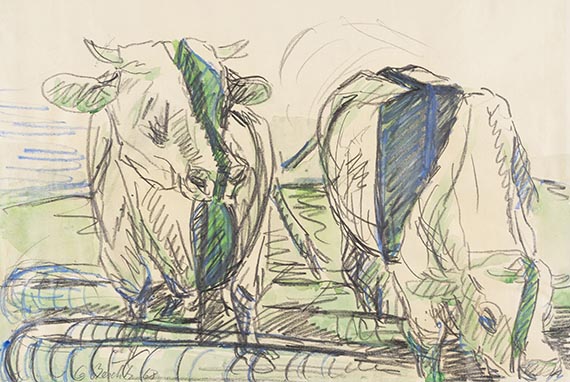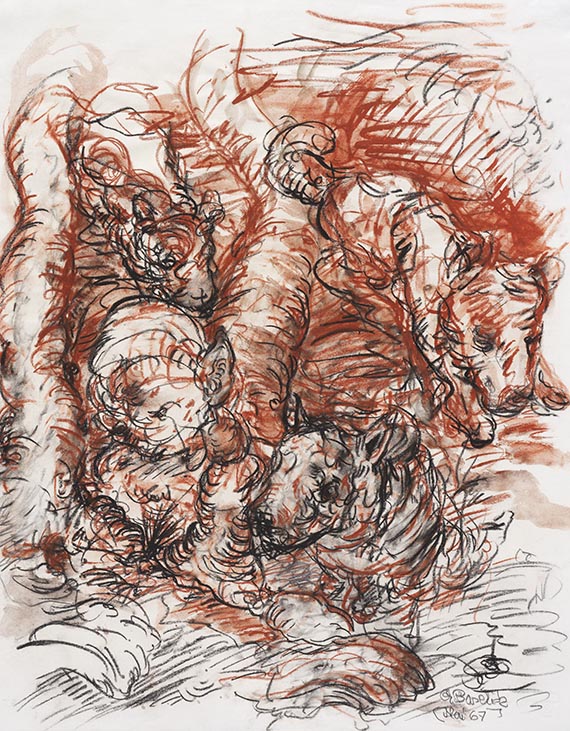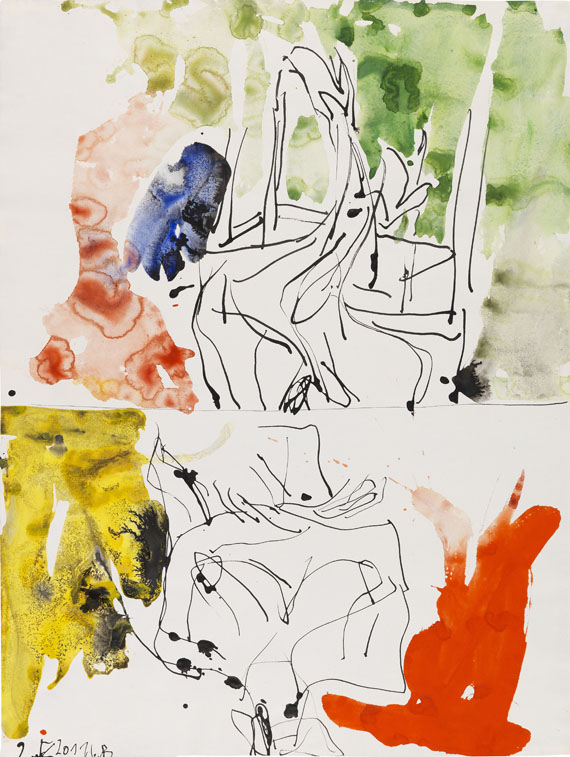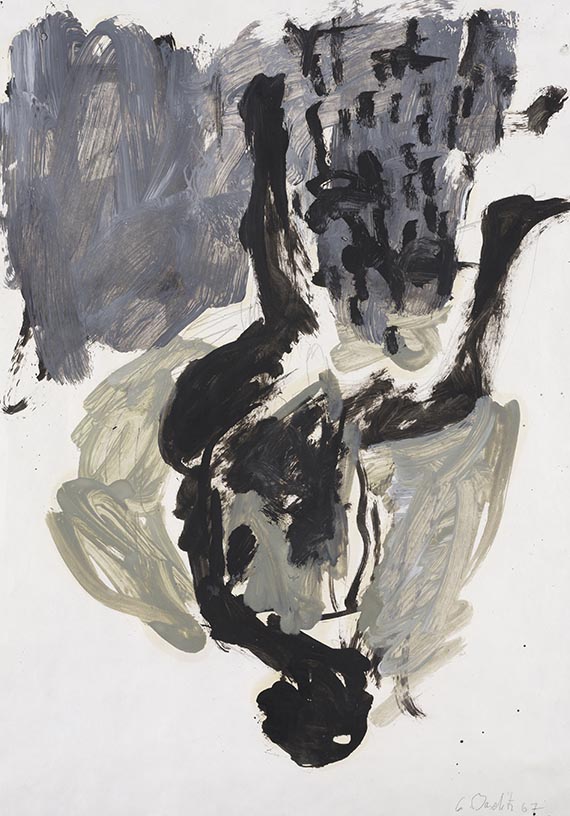198
Georg Baselitz
Zwei Kühe, 1968.
Watercolor and pastel chalks
Prix d´après-vente: € 30,000 / $ 33,900
Zwei Kühe. 1968.
Watercolor and pastel chalks.
Signed and dated in the lower left. Signed, dated and titled on the reverse. On off-white laid paper. 35.1 x 50.1 cm (13.8 x 19.7 in), size of sheet. [JS].
• This work is from Baselitz's bold early body of work from the 1960s, which includes the famous “Hero” and “Fraktur” paintings.
• An exceptionally colorful work on paper, created in the context of Baselitz's rebellious “Fraktur” painting “Zwei halbe Kühe” (Two Half Cows, 1968).
• This work, as well as his first “upside-down” painting “Der Wald auf dem Kopf” from 1969), reveals progressive pictorial ideas that engage with art historical tradition.
• Baselitz attempts to disrupt the subject matter through his fragmented painting style and to confuse our traditional viewing habits as much as possible..
We are grateful to the Georg Baselitz Archive, Munich, for the kind expert advice. The work is registered in the archive of the artist's works.
PROVENANCE: Private collection, South Germany.
EXHIBITION: Siegfried Gnichwitz (ed.), Kunst geht in die Farbik. Dokumentation eines Experiments, Bonn-Bad Godesberg, Wissenschaftszentrum des Stifterverbandes für die Deutsche Wissenschaft, May-June 1987, p. 128 (illustrated).
"I love how art historians analyze Cranach, Correggio, and so on, but as a painter, I've never been particularly interested in that. I draw my inspiration from elsewhere, especially from the boldness exhibited by certain painters. The audacity to change images, to recreate them."
Georg Baselitz, quoted from: https://artinwords.de/wien-khm-georg-baselitz/
Watercolor and pastel chalks.
Signed and dated in the lower left. Signed, dated and titled on the reverse. On off-white laid paper. 35.1 x 50.1 cm (13.8 x 19.7 in), size of sheet. [JS].
• This work is from Baselitz's bold early body of work from the 1960s, which includes the famous “Hero” and “Fraktur” paintings.
• An exceptionally colorful work on paper, created in the context of Baselitz's rebellious “Fraktur” painting “Zwei halbe Kühe” (Two Half Cows, 1968).
• This work, as well as his first “upside-down” painting “Der Wald auf dem Kopf” from 1969), reveals progressive pictorial ideas that engage with art historical tradition.
• Baselitz attempts to disrupt the subject matter through his fragmented painting style and to confuse our traditional viewing habits as much as possible..
We are grateful to the Georg Baselitz Archive, Munich, for the kind expert advice. The work is registered in the archive of the artist's works.
PROVENANCE: Private collection, South Germany.
EXHIBITION: Siegfried Gnichwitz (ed.), Kunst geht in die Farbik. Dokumentation eines Experiments, Bonn-Bad Godesberg, Wissenschaftszentrum des Stifterverbandes für die Deutsche Wissenschaft, May-June 1987, p. 128 (illustrated).
"I love how art historians analyze Cranach, Correggio, and so on, but as a painter, I've never been particularly interested in that. I draw my inspiration from elsewhere, especially from the boldness exhibited by certain painters. The audacity to change images, to recreate them."
Georg Baselitz, quoted from: https://artinwords.de/wien-khm-georg-baselitz/
His outstanding artistic work, which has repeatedly found new creative ways to challenge and perpetuate art historical traditions since the 1960s, has made Georg Baselitz one of the most famous figures in contemporary German art. With his influential figurative works, he defies established categories and repeatedly challenges our traditional perception of art. In 1963, Baselitz rose to fame overnight with a significant controversy. His paintings “Die große Nacht im Eimer” (The Great Night in the Bucket, 1962) and “Der nackte Mann” (The Naked Man, 1962), shown in a solo exhibition at the Werner & Katz Gallery in Berlin, caused a major scandal. The latter depicts an emaciated male nude lying dead in a grave-like hole with an oversized penis. A shocking painting that alludes both to depictions of Christ's corpse and to images from Nazi concentration camps, which were ignored by large parts of German society after the war. Both paintings were confiscated by the public prosecutor's office on charges of pornography. The following day, the BZ newspaper wrote: “This is a scandal the likes of which Berlin has not seen since the end of the war.” In his famous “Hero” paintings (1965/66), in which Baselitz stages physically and emotionally broken figures, the rebellious artist confronts post-war German society just as relentlessly with its painful past. In the late 1960s, these antiheroes were followed by the “Fraktur” paintings (1966–1968), which also contain an inherent destructive element, as they visually dismantle the subject. Our colorful paper work was created in the context of the painting “Zwei halbe Kühe” (Two Half Cows, 1968), which Ketterer Kunst sold with great success from the same southern German private collection in 2017. With energetic strokes, Baselitz captured the two animals' shapes, which are partly broken down into contrasting areas of color. Shortly after this critical early creative phase, Baselitz produced his first upside-down painting, “Der Wald auf dem Kopf” (The Forest on the Head, Museum Ludwig, Cologne), in 1969. Once again, Baselitz radically challenged our traditional viewing habits. This step, which would become Baselitz's artistic trademark, was another powerful act of painterly liberation. “The act of painting itself emancipates itself from representation, from the pictorial, and at the same time allows the works to appear representational and non-representational.” (Toni Stoss, in: Georg Baselitz, Gemälde und Skulpturen 1960-2008, p. 8). [JS]
198
Georg Baselitz
Zwei Kühe, 1968.
Watercolor and pastel chalks
Prix d´après-vente: € 30,000 / $ 33,900
Commission, taxes et droit de suite
Cet objet est offert avec imposition régulière ou avec imposition différentielle.
Calcul en cas d'imposition différentielle:
Prix d’adjudication jusqu’à 800 000 euros : frais de vente 32 %.
Des frais de vente de 27% sont facturés sur la partie du prix d’adjudication dépassant 800 000 euros. Ils sont additionnés aux frais de vente dus pour la partie du prix d’adjudication allant jusqu’à 800 000 euros.
Des frais de vente de 22% sont facturés sur la partie du prix d’adjudication dépassant 4 000 000 euros. Ils sont additionnés aux frais de vente dus pour la partie du prix d’adjudication allant jusqu’à 4 000 000 euros.
La commission comprend la TVA, mais celle-ci n'est pas indiquée.
Calcul en cas d'imposition régulière:
Prix d'adjudication jusqu'à 800 000 € : 27 % de commission.
Prix d'adjudication supérieur à 800 000 € : montants partiels jusqu'à 800 000 € 27 % de commission, montants partiels supérieurs à 800 000 € : 21 % de commission.
Prix d'adjudication supérieur à 4.000 000 € : montants partiels supérieurs à 4.000 000 € : 15 % de commission.
La TVA légale de 7 % est prélevée sur la somme du prix d'adjudication et de la commission.
Si vous souhaitez appliquer l'imposition régulière, merci de bien vouloir le communiquer par écrit avant la facturation.
Calcul en cas de droit de suite:
Pour les œuvres originales d’arts plastiques et de photographie d’artistes vivants ou d’artistes décédés il y a moins de 70 ans, soumises au droit de suite, une rémunération au titre du droit de suite à hauteur des pourcentages indiqués au § 26, al. 2 de la loi allemande sur les droits d’auteur (UrhG) est facturée en sus pour compenser la rémunération liée au droit de suite due par le commissaire-priseur conformément au § 26 UrhG. À ce jour, elle est calculée comme suit :
4 pour cent pour la part du produit de la vente à partir de 400,00 euros et jusqu’à 50 000 euros,
3 pour cent supplémentaires pour la part du produit de la vente entre 50 000,01 et 200 000 euros,
1 pour cent supplémentaire pour la part entre 200 000,01 et 350 000 euros,
0,5 pour cent supplémentaire pour la part entre 350 000,01 et 500 000 euros et
0,25 pour cent supplémentaire pour la part au-delà de 500 000 euros.
Le total de la rémunération au titre du droit de suite pour une revente s’élève au maximum à 12 500 euros.
Calcul en cas d'imposition différentielle:
Prix d’adjudication jusqu’à 800 000 euros : frais de vente 32 %.
Des frais de vente de 27% sont facturés sur la partie du prix d’adjudication dépassant 800 000 euros. Ils sont additionnés aux frais de vente dus pour la partie du prix d’adjudication allant jusqu’à 800 000 euros.
Des frais de vente de 22% sont facturés sur la partie du prix d’adjudication dépassant 4 000 000 euros. Ils sont additionnés aux frais de vente dus pour la partie du prix d’adjudication allant jusqu’à 4 000 000 euros.
La commission comprend la TVA, mais celle-ci n'est pas indiquée.
Calcul en cas d'imposition régulière:
Prix d'adjudication jusqu'à 800 000 € : 27 % de commission.
Prix d'adjudication supérieur à 800 000 € : montants partiels jusqu'à 800 000 € 27 % de commission, montants partiels supérieurs à 800 000 € : 21 % de commission.
Prix d'adjudication supérieur à 4.000 000 € : montants partiels supérieurs à 4.000 000 € : 15 % de commission.
La TVA légale de 7 % est prélevée sur la somme du prix d'adjudication et de la commission.
Si vous souhaitez appliquer l'imposition régulière, merci de bien vouloir le communiquer par écrit avant la facturation.
Calcul en cas de droit de suite:
Pour les œuvres originales d’arts plastiques et de photographie d’artistes vivants ou d’artistes décédés il y a moins de 70 ans, soumises au droit de suite, une rémunération au titre du droit de suite à hauteur des pourcentages indiqués au § 26, al. 2 de la loi allemande sur les droits d’auteur (UrhG) est facturée en sus pour compenser la rémunération liée au droit de suite due par le commissaire-priseur conformément au § 26 UrhG. À ce jour, elle est calculée comme suit :
4 pour cent pour la part du produit de la vente à partir de 400,00 euros et jusqu’à 50 000 euros,
3 pour cent supplémentaires pour la part du produit de la vente entre 50 000,01 et 200 000 euros,
1 pour cent supplémentaire pour la part entre 200 000,01 et 350 000 euros,
0,5 pour cent supplémentaire pour la part entre 350 000,01 et 500 000 euros et
0,25 pour cent supplémentaire pour la part au-delà de 500 000 euros.
Le total de la rémunération au titre du droit de suite pour une revente s’élève au maximum à 12 500 euros.




 Lot 198
Lot 198 


